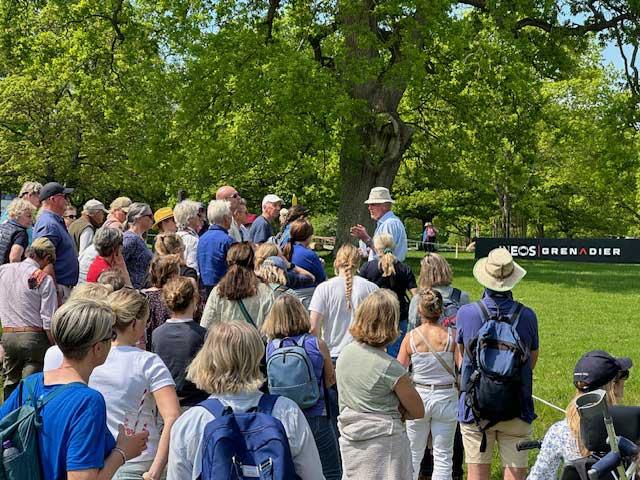F&I Report on Badminton course walk with Eric Smiley FBHS
We gathered at fence 2 for a sunny 10am start on Thursday 9th May, with a lovely warm welcome from Ann Bostock who introduced Eric.
Eric started by talking about the different types of course walk:
- For the rider.
- For the coach.
- For the owner.
And how to approach those differently.

Then he threw a question at us to consider as we carried on. ‘Do course designers set the trend or follow the trend?’
We then moved forward to fence 3 which had the use of a mound. We discussed the use of terrain within course designing. The fences cannot get higher and wider than the maximums allowed but using the terrain can make courses more technical by posing more questions.
We went on to talk about the 3 types of competitors and the categories they fall under:
We talked about how by watching these 3 types of riders, it will be evident which category they fall into in regards to their approach and time taken to prepare.
We then discussed the little gremlin on a rider’s shoulder and how they can’t allow that voice to put doubt into their minds. Mental strength and emotional control is needed to be a top competitive rider.
‘How do the Badminton crowds affect a horse and rider?’ The horse could be distracted, having not seen this volume of the public and felt this atmosphere before at lower levels, so keeping their mind on the job in hand is needed from the rider. The rider might feel like they are travelling at a greater speed when crossing the country with crowds standing still in their peripheral vision. For example you are more aware of your speed when driving a car along a road lined with trees.
Approaching the lake combination, after jumping in at the top end, we have to canter past fences. ‘What can this do to the horse’s mindset?’ Then the crowds around the lake will be a distraction – the horse can lose focus. It’s then the rider’s job to make sure the horse is mentally prepared for the questions ahead. Eric talked about the frangible pins at the entry wall to the lake. The anticipation of the water on landing will affect the horse’s bascule and they might hang in the air, leaving their hind legs, which could lead to the top rail /section dropping and causing penalties.
The rider’s mind needs to stay positive and sharp in the let-up stretch after the lake. In this let-up stretch we felt the ground changed to soft underfoot. Eric talked about a different action the horse may have galloping down over this ground, how this may affect time and energy levels.
The triple bar was flagged by Eric as one of the fences he sees jumped least well. He discussed that this fence does not need a particularly big jump but riders very often feel they do, to get the spread. Instead, just get in as close to the bottom rail as possible. Horses will only have a certain amount of ‘big jumps’ in them and this would be wasted at this fence.
Course design built on longer distances will encourage bold riding. This also tests the honesty of the horse and rider to the line. Eric Winter has designed the course for positive, bold riding. When walking the distances we need to walk to the flags and not the base of the fence. This closes the escape routes and will help hold your line true.
We then discussed the use of the rail on top of the drop fence which will encourage the horse to jump down rather than slide and shuffle off the edge. This will make riding to the distance easier for both horse and rider.
After fence 26 Eric discussed that the rider should be sniffing home but will be asking their horse to dig deep. The rider must ride to what they feel they have left in the tank.
To this end, Eric explained how this year the finish has changed somewhat, by removing excess terrain from a tired horse’s last few fences.
In answer to Eric’s original question of ‘Do course designers set the trend or follow the trend?’ he felt that if the trends keep changing constantly, how much harder and more technical can we go?
Let’s conclude with Eric’s definition of partnership. ‘Two people, striving for a common goal’. Eric likes to insert, ‘both knowing their role,’ The rider’s role is the line, the horse handles the jump.
This was a fantastic course walk delivered by Eric, giving us lots of thought-provoking questions. It will be interesting to watch the competitors on Saturday tackle this superb track.
PS we also had the chance to visit the Badminton 75th Anniversary museum – if you’re there later in the week, don’t miss it. Many gems, including pictures of old-style fences, some daunting drops, and not a frangible pin in sight… being jumped by famous names in hunt caps! And the chance to inspect the magnificent Badminton Trophy up close. A delightful display.
Thank you to Ann for organising a brilliant day for us all, Eric for delivering superbly, and the F&I for giving us this opportunity.
Emily Farleigh BHSI
